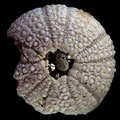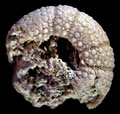The type species is problematic in that it lacks well defined sculturing and has only rather indistinct pits. Its affinities to Temnopleuridae is therefore not certain. Nor is it clear that many of the species currently assigned to this genus truly belong here. Several species assigned to Arbacina do show classic temnopleurid sculpturing, with deep pitting under the primary tubercles. Forms such as A. savini Lambert, 1910, without pitting, seem like good Psammechinus. A major revision of all the species previously assigned to this genus is required.
Mortensen (1943) separated Arbacina from Genocidaris stating that the former had "tubercles not indented, depressions on horizontal sutures present" while the latter had " tubercles indented, depressions in the horizontal sutures (usually) lacking". Nevertheless, the type species of both genera have almost identical ornamentation, with dense secondary tuberculation and small pits confined to immediately beneath the primary interambulacral tubercles.
Mortensen, T. 1943. A monograph of the Echinoidea Part III.2, Camarodonta 1. C. A. Reitzel, Copenhagen.
Borghi, E., Campos, I. B. & Garcia, A. R. 2005. Arbacina romana (Merian, 1858) from the lower Pleistocene of Favignana Island (Sicily). Parva Naturalia 7, 47-71.
Pomel, A. 1869. Revue des échinodermes et de leur classification pour servir d'introduction à l'étude des fossiles. Deyrolle, Paris, 67 pp.





